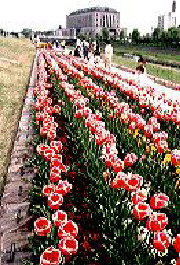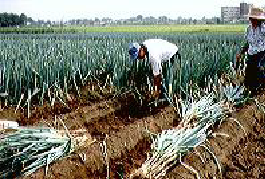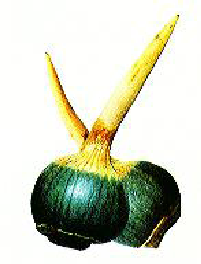Koshigaya-Negi
Allium fistulosum is a type of onion that has a long white stalk that connects an elongate bulb, not much thicker than the stalk, to long, hollow, tube-like leaves. Allium fistulosum are called Negi in Japanese, and are known by a number of names in English. These include Welsh Onion and Japanese Bunching Onion. Allium fistulosum grown in Koshigaya are called Koshigaya-Negi, and are known for having a strong stalk that does not break into pieces during cooking. Although it is unknown exactly when such high-quality Negi were first cultivated in the Koshigaya area, there is documentation suggesting that it was during the Edo Period (1603 - 1867). Koshigaya City’s administration has encouraged the cultivation of Koshigaya-Negi in Mashimori, Nakajima and other areas of the city, where there is farmland surrounded by natural embankments, and much farmland in these areas has been converted into Negi fields. Koshigaya City is now well known for its Negi, and ranks with Fukaya City as a famous Negi-producing area.
Arrowhead Tubers
The Arrowhead is a perennial aquatic herb belonging to the Alismataceae family, and is called Kuwai in Japanese. The Arrowhead has creeping roots that spread underground, with the tip of the roots swelling to form edible tubers. In Japan the Arrowhead is considered to be lucky because of the way in which a large sprout grows from its tubers, and Arrowhead tubers are often used in dishes eaten at New Years and on other special occasions. The Arrowhead is said to have been imported from China in the Nara Period (710 - 794), and has been cultivated in the Koshigaya area since the middle of the Edo Period (1603 - 1867). Arrowhead tubers are now cultivated in the Dewa and Ogishima areas of Koshigaya City. Arrowhead tubers are harvested for shipping in November and December, and because harvesting is carried out by hand in cold conditions, the scale of cultivation is limited, and has decreased slightly in recent years. However, Koshigaya City still leads the other main Arrowhead tuber-producing areas in Hiroshima Prefecture and Aichi Prefecture as the largest producer of arrowhead tubers in Japan. After harvesting, large tubers are shipped to the Keihin Area (Tokyo and Yokohama), and small tubers are shipped to the Kansai Area (Osaka and Kyoto). Again, to promote the consumption of Arrowhead tubers, Kuwai confectionary and a low-malt, Kuwai beer are now being produced in Koshigaya.
Tulips

Cut tulips are one of Koshigaya City’s major horticultural products, and to meet customer demand, tulip bulbs are ordered from Toyama and Niigata Prefectures, and from as far away as Holland. After being stored at low temperature in the city’s storehouse, tulip bulbs are raised in greenhouses throughout the city. The growing season is from the start of December until early April, and various measures are continually being taken to improve the quality of the tulips produced and to reduce the costs involved in their production. The tulips produced are shipped to Tokyo and other towns and cities in the Kanto Area (the Tokyo Metropolitan Area and Kanagawa, Chiba, Saitama, Gunma and Tochigi Prefectures), with the largest shipments being made at Christmas and New Years, and during the graduation season. A variety of other flowers are also produced in Koshigaya City. These include freesias and lilies, which are raised from bulbs to be sold as cut flowers, as well as orchids and roses. To increase public awareness about horticulture in Koshigaya City, flower growers from throughout the city hold the Hana Fiesuta, a festival of flowers, in the concourse of Shin-Koshigaya Station every January. Again, flower exhibitions are held in the 1st floor lobby of the Koshigaya City Office in March and June. The exhibition in March features tuips, and the exhibition in June features orchids, lilies and other flowers.
Tarobee-Mochi
It is thought that the cultivation of Tarobee-Mochi began early in the Edo Period (1603 - 1867) with Tarobee Aida’s selective cultivation of glutinous rice. Aida, who held the hereditary position of headsman of the Shichono Village (Shichono-Mura), selectively cultivated varieties of glutinous rice that matured early and were tall in height in an attempt to avoid crop damage caused by typhoons. Aida succeeded in creating a variety of glutinous rice suited to cultivation in low-lying, damp areas in 1596, and this variety came to be known as Tarobee-Mochi. Tarobee-Mochi, which is known for its unique taste, chewiness and stickiness, was extremely popular from start of the Meiji Period (1868 - 1912) until early in the Showa Period (1926 - 1989), and received the honors of being offered to the imperial family and receiving the patronage of the Imperial Household Agency. Again, it is said that in the early part of the Showa Period, there was much competition amongst confectioners from Tokyo who sought to buy Tarobee-Mochi from Dewa Village (Dewa-Mura). However, during the Second World War, the promulgation of laws relating to the control of food quality saw the price of Tarobee-Mochi reduced to that of other types of rice. This combined with Tarobee-Mochi's small yield and tendency to topple in high winds, saw a decrease in the number of farmers cultivating it. At present there are very few farmers cultivating Tarobee-Mochi, so to preserve this variety of glutinous rice, since 1993,Koshigaya City's administration has offered contracts to farmers for its cultivation and is running programs to promote its cultivation.


